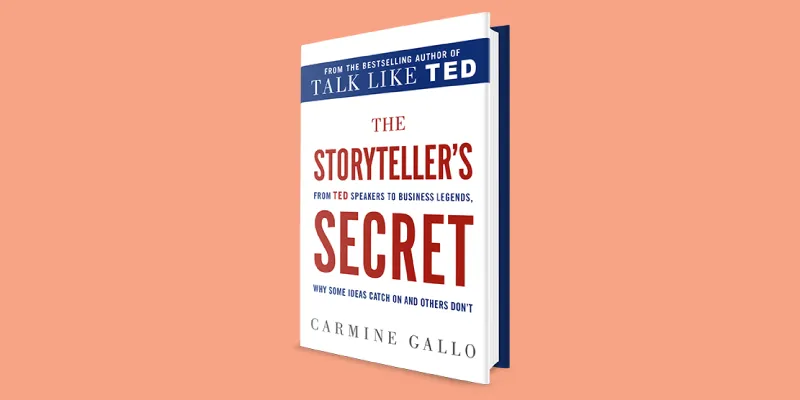Secrets of storytelling: lessons from 50 successful entrepreneurs, leaders and TED speakers
Storytelling has been used effectively by leaders and entrepreneurs to inspire, motivate, educate, build brands, launch movements, and even change lives. Techniques such as framing, elevation and connection used by 50 outstanding speakers are described in the superb new book ‑ The Storyteller’s Secret: How TED Speakers and Inspirational Leaders Turn their Passion into Performance.

Carmine Gallo is author of the bestseller Talk Like TED as well as The Presentation Secrets of Steve Jobs and The Apple Experience. He is a communications coach for brands such as Pfizer, LinkedIn, Intel, and Coca Cola, and columnist for Forbes.com and Entrepreneur.com.
“The ability to sell our ideas in the form of story is more important than ever. Ideas are the currency of the 21st century. In the information age, the knowledge economy, you are only as valuable as your ideas,” begins Carmine. “Storytelling is the act of framing an idea as a narrative to inform, illuminate and inspire,” he says, describing it as a combination of art and science.
Great storytellers include elements of their own personal struggles and failures in life. Rags-to-riches, sand-to-pearl, stone-to-diamond and grapes-to-wine are symbols of conquest over adversity and transformative success, and help build bonds with audiences.
“Embrace your history because it’s the stuff from which legends are made and legacies are left. Storytelling is not something we do. Storytelling is who we are,” explains Carmine (see also YourStory’s Changemaker Story Canvas, a free visualisation tool for storytelling).
The 268 page-book is divided into five categories of storytellers, with each profile describing tools and techniques used for effective impact (see my summary of the clusters in Table 1). The book ends with a useful checklist of action items for speakers.
Table 1: Categories of Storytellers
“The greatest waste is an unfulfilled idea that fails to connect with audiences, not because it’s a bad idea, but because it’s not packaged in a way that moves people,” says Carmine. Passion, courage, perseverance, creativity and commitment should come through in the story. A good story with a call to action can galvanise the audience.
Effective storytelling requires continual internal dialogue as well as understanding the audience. Everyone has a number of back stories, which become active at different points of time. The story has to be able to convince yourself before it can convince others. “Craft a personal legend. If you can’t tell it, you can’t sell it,” advises Carmine.
In the corporate world, impact stories are as powerful as numbers and features which describe products and their adoption rates. “Storytelling is a force replicator,” says Carmine. The case studies illustrate stylistic elements such as analogy, metaphor, anaphor and repetition, but also call for brevity and the use of short words rather than jargon and fluff.
Consistent and continual storytelling is a powerful way to reinforce corporate culture and amplify purpose, with modern-day extensions like employees’ videos on the intranet. “Culture is a story that must be shared every day,” says Carmine. In the advertising world, great commercials are the ones that tell stories; in the medical world there is even a practice called ‘narrative medicine’.
The details of the above storytelling approaches are well explained in the book, with key elements extracted in the concluding chapter. These include: dream in moonshots; tie the corporate vision to the founder’s story; make stories at least 65 percent of your presentation time; tell your story in parts; wrap data in stories; and take every opportunity to hone your presentation skills.
The book ends with a checklist of questions for each storytelling element. For example, what are you passionate about? What is the trigger event in your story? What should be the audience takeaway? Can you speak without notes and without slides? What rhetorical questions will you be raising? (See also my reviews of the books Dare, Dream, Do by Whitney Johnson; Whoever Tells the Best Story Wins by Annette Simmons; and First-Time Leader by George Bradt and Gillian Davis).
“The universe is made of stories, not atoms,” said poet Muriel Rukeyser. In the political world, storytelling helps leaders became orators and tear down the walls of injustice, the way Nelson Mandela did. In the business world, storytelling helps brands build trust and relationships with customers.
But storytelling is the most under-rated skill among entrepreneurs, according to venture capitalist Ben Horowitz. Fortunately, many resources are now available for founders to better understand storytelling. Many large corporates have already realised its importance; for example, SAP has a marketing manager with the title Chief Storyteller.
“Storytellers give us hope, and hope is a universal desire,” Carmine sums up.
The book is packed with useful and inspiring quotes, and it would be fitting to end this review with a few of them.
Life isn’t about finding yourself. Life is about creating yourself. – George Bernard Shaw
A great storyteller helps find people figure out not only what matters in the world, but also why it matters. – Maria Popova
If they’re laughing, they’re listening. – Ken Robinson
If something can’t be explained on the back of an envelope, it’s rubbish. – Richard Branson
Simple can be harder than complex. – Steve Jobs
Don’t address their brains. Address their hearts. – Nelson Mandela







